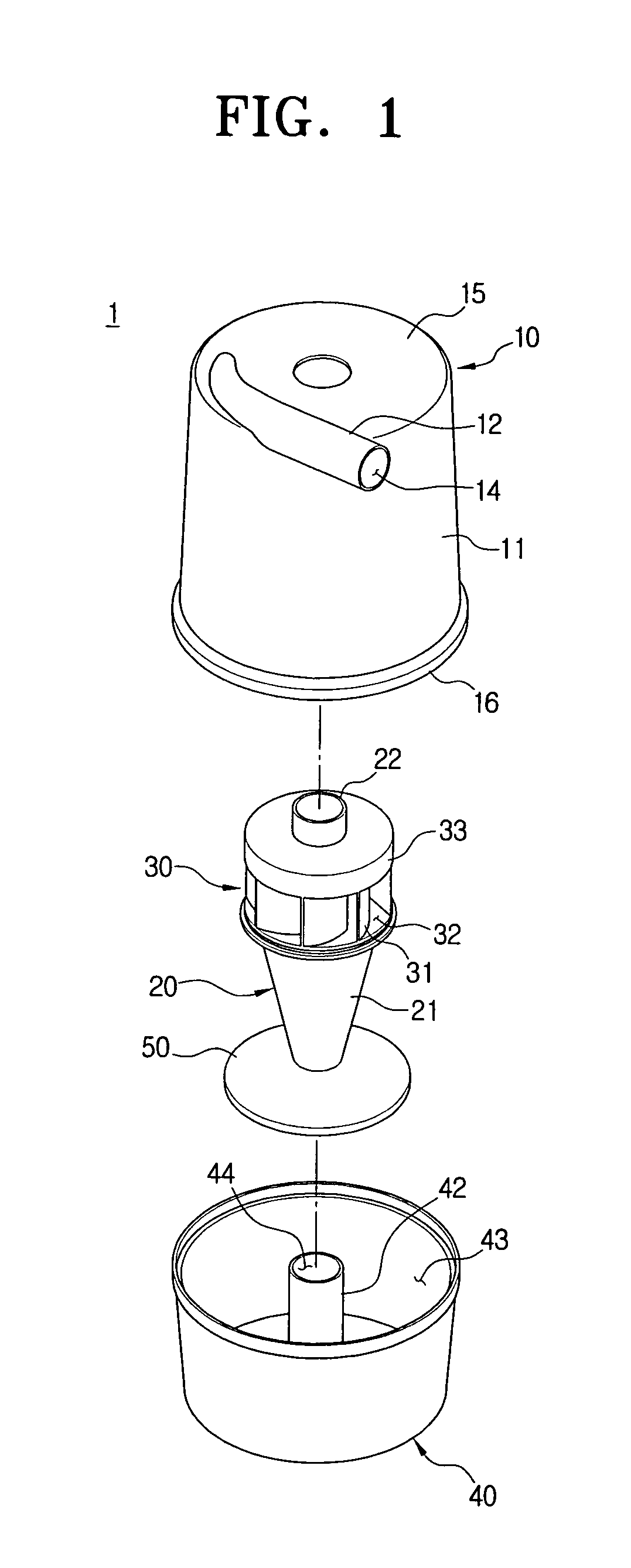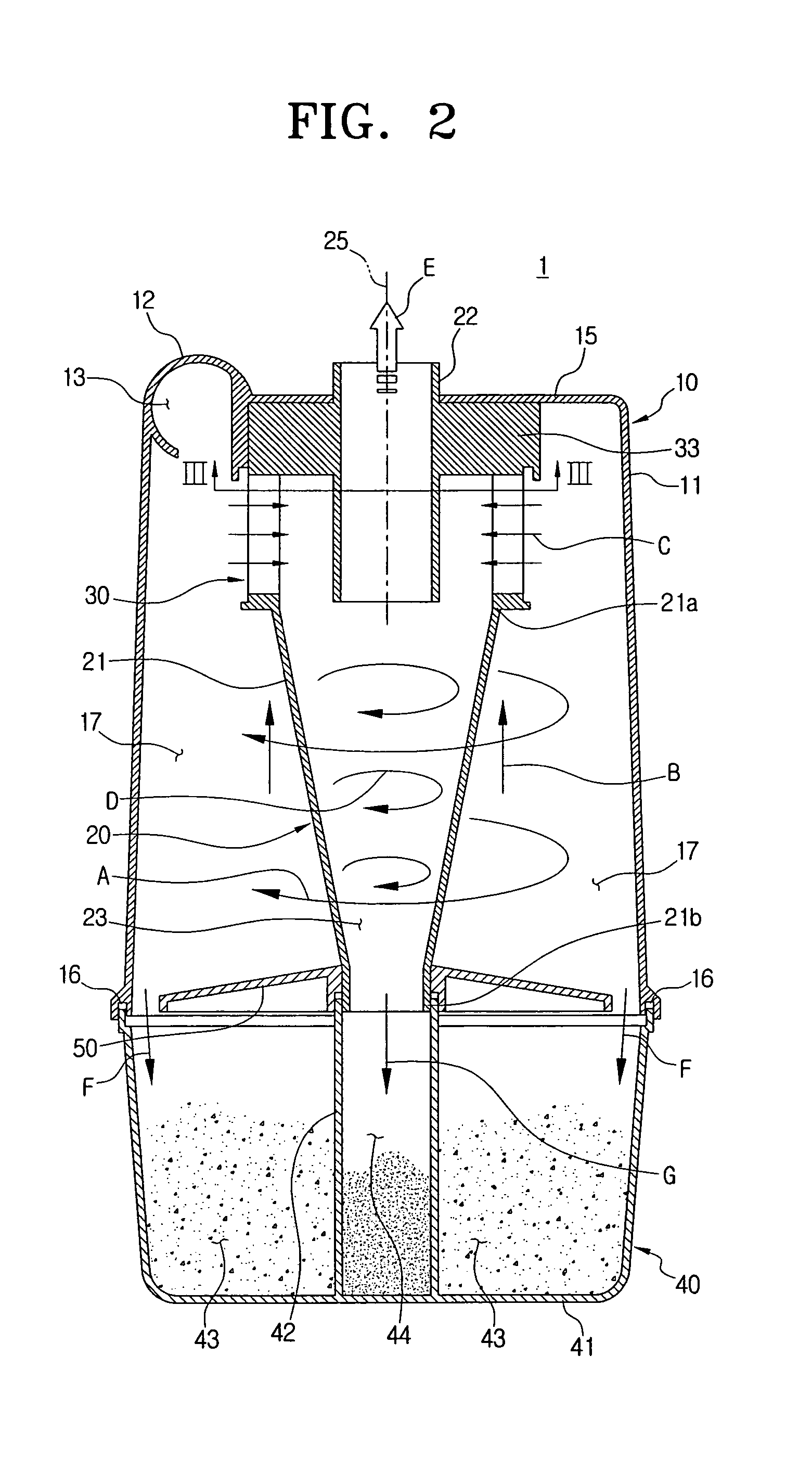Cyclone dust collecting apparatus for vacuum cleaner
a vacuum cleaner and dust collection technology, applied in the field of vacuum cleaners, can solve the problems of large pressure loss, inability of conventional cyclone dust collection apparatus to separate fine dust from dust-laden air, etc., and achieve the effect of small pressure loss and higher fine dust collection efficiency
- Summary
- Abstract
- Description
- Claims
- Application Information
AI Technical Summary
Benefits of technology
Problems solved by technology
Method used
Image
Examples
first embodiment
[0052]Referring to FIGS. 1 and 2, a cyclone dust collecting apparatus 1 for a vacuum cleaner according to the present disclosure includes a first cyclone 10, a second cyclone 20, and a dust collecting receptacle 40.
[0053]The first cyclone 10 draws-in outside air containing dust, dirt, and so on (hereinafter, referred to as dust-laden air), and forces the dust-laden air to downwardly whirl inside the first cyclone 10 so that dust, dirt and so on (hereinafter, referred to as dust) is separated from the dust-laden air by centrifugal force. Then, the first cyclone 10 discharges air having dust partially removed (hereinafter, referred to as semi-clean air) to the second cyclone 20.
[0054]The first cyclone 10 has a first cyclone body 11 and an air suction pipe 12. The first cyclone body 11 is formed in a substantially hollow cylindrical shape with a top end closed by a top wall 15 and an opened bottom end. At an upper side of the first cyclone body 11 is formed an air suction hole 13 throu...
second embodiment
[0069]Hereinafter, a cyclone dust collecting apparatus 2 for a vacuum cleaner according to the present disclosure is explained with reference to FIGS. 5 to 8D.
[0070]Referring to FIGS. 5 and 6, a cyclone dust collecting apparatus 2 for a vacuum cleaner according to the second embodiment of the present disclosure includes a first cyclone 10, a second cyclone 20′, and a dust collecting receptacle 40.
[0071]The cyclone dust collecting apparatus 2 according to the second embodiment has the same first cyclone 10 and dust collecting receptacle 40 as those of the cyclone dust collecting apparatus 1 according to the first embodiment as described above except the second cyclone 20′. Therefore, the second cyclone 20′ is only described hereinafter.
[0072]The second cyclone 20′ is disposed inside the first cyclone 10, takes the semi-clean air C discharged from the first cyclone 10, and forces the semi-clean air C to form the second downwardly whirling air current D. Then, fine dust is separated fr...
third embodiment
[0082]Hereinafter, a cyclone dust collecting apparatus 3 for a vacuum cleaner according to the present disclosure is described with reference to FIGS. 9 and 10.
[0083]Referring to FIGS. 9 and 10, a cyclone dust collecting apparatus 3 for a vacuum cleaner according to the third embodiment of the present disclosure includes a first cyclone 110, a second cyclone 120, a filtering member 100, and a dust collecting receptacle 140.
[0084]The first cyclone 110 is substantially the same as the first cyclone 10 of the cyclone dust collecting apparatus 1 according to the first embodiment, exception that the air-discharging pipe 117 is disposed at a top wall 15 of the first cyclone body 11. The air-discharging pipe 117 discharges purified air E passed through the filtering member 100 to the vacuum generator (not shown).
[0085]The second cyclone 120 is disposed inside the first cyclone 110. The semi-clean air C discharged from the first cyclone 110 enters to form a second downwardly whirling air cu...
PUM
| Property | Measurement | Unit |
|---|---|---|
| gravity | aaaaa | aaaaa |
| elastic | aaaaa | aaaaa |
| centrifugal force | aaaaa | aaaaa |
Abstract
Description
Claims
Application Information
 Login to View More
Login to View More - R&D
- Intellectual Property
- Life Sciences
- Materials
- Tech Scout
- Unparalleled Data Quality
- Higher Quality Content
- 60% Fewer Hallucinations
Browse by: Latest US Patents, China's latest patents, Technical Efficacy Thesaurus, Application Domain, Technology Topic, Popular Technical Reports.
© 2025 PatSnap. All rights reserved.Legal|Privacy policy|Modern Slavery Act Transparency Statement|Sitemap|About US| Contact US: help@patsnap.com



